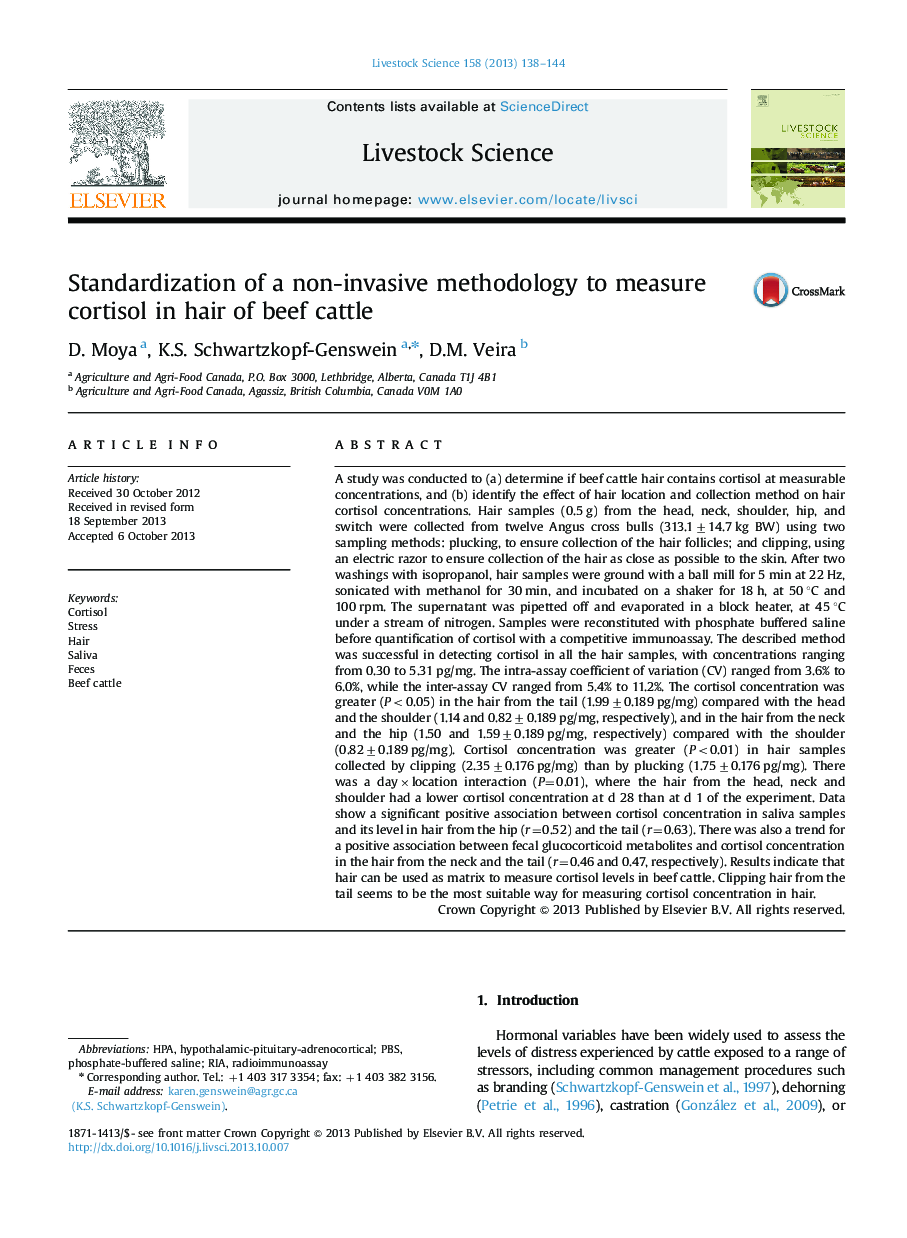| کد مقاله | کد نشریه | سال انتشار | مقاله انگلیسی | نسخه تمام متن |
|---|---|---|---|---|
| 5790301 | 1553974 | 2013 | 7 صفحه PDF | دانلود رایگان |
عنوان انگلیسی مقاله ISI
Standardization of a non-invasive methodology to measure cortisol in hair of beef cattle
ترجمه فارسی عنوان
استاندارد سازی یک روش غیر تهاجمی برای اندازه گیری کورتیزول در موهای گاو گوشتی
دانلود مقاله + سفارش ترجمه
دانلود مقاله ISI انگلیسی
رایگان برای ایرانیان
کلمات کلیدی
PBSRIAStress - استرس یا فشار روانیSaliva - بزاق radioimmunoassay - رادیوایمونواسیPhosphate-buffered saline - محلول نمک فسفات با خاصیت بافریFeces - مدفوعHair - موHPA - میلی بار یا هکتوپاسکالhypothalamic-pituitary-adrenocortical - هیپوتالاموس - هیپوفیز - غیر آلرژیکcortisol - کورتیزولBeef cattle - گاو گوشت گاو
موضوعات مرتبط
علوم زیستی و بیوفناوری
علوم کشاورزی و بیولوژیک
علوم دامی و جانورشناسی
چکیده انگلیسی
A study was conducted to (a) determine if beef cattle hair contains cortisol at measurable concentrations, and (b) identify the effect of hair location and collection method on hair cortisol concentrations. Hair samples (0.5 g) from the head, neck, shoulder, hip, and switch were collected from twelve Angus cross bulls (313.1±14.7 kg BW) using two sampling methods: plucking, to ensure collection of the hair follicles; and clipping, using an electric razor to ensure collection of the hair as close as possible to the skin. After two washings with isopropanol, hair samples were ground with a ball mill for 5 min at 22 Hz, sonicated with methanol for 30 min, and incubated on a shaker for 18 h, at 50 °C and 100 rpm. The supernatant was pipetted off and evaporated in a block heater, at 45 °C under a stream of nitrogen. Samples were reconstituted with phosphate buffered saline before quantification of cortisol with a competitive immunoassay. The described method was successful in detecting cortisol in all the hair samples, with concentrations ranging from 0.30 to 5.31 pg/mg. The intra-assay coefficient of variation (CV) ranged from 3.6% to 6.0%, while the inter-assay CV ranged from 5.4% to 11.2%. The cortisol concentration was greater (P<0.05) in the hair from the tail (1.99±0.189 pg/mg) compared with the head and the shoulder (1.14 and 0.82±0.189 pg/mg, respectively), and in the hair from the neck and the hip (1.50 and 1.59±0.189 pg/mg, respectively) compared with the shoulder (0.82±0.189 pg/mg). Cortisol concentration was greater (P<0.01) in hair samples collected by clipping (2.35±0.176 pg/mg) than by plucking (1.75±0.176 pg/mg). There was a dayÃlocation interaction (P=0.01), where the hair from the head, neck and shoulder had a lower cortisol concentration at d 28 than at d 1 of the experiment. Data show a significant positive association between cortisol concentration in saliva samples and its level in hair from the hip (r=0.52) and the tail (r=0.63). There was also a trend for a positive association between fecal glucocorticoid metabolites and cortisol concentration in the hair from the neck and the tail (r=0.46 and 0.47, respectively). Results indicate that hair can be used as matrix to measure cortisol levels in beef cattle. Clipping hair from the tail seems to be the most suitable way for measuring cortisol concentration in hair.
ناشر
Database: Elsevier - ScienceDirect (ساینس دایرکت)
Journal: Livestock Science - Volume 158, Issues 1â3, December 2013, Pages 138-144
Journal: Livestock Science - Volume 158, Issues 1â3, December 2013, Pages 138-144
نویسندگان
D. Moya, K.S. Schwartzkopf-Genswein, D.M. Veira,
